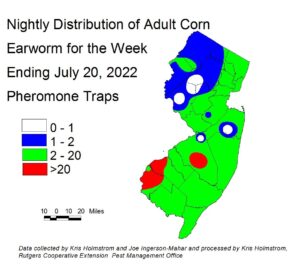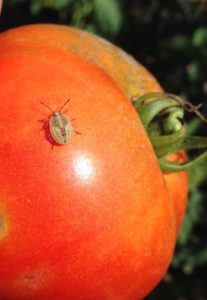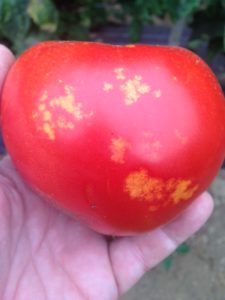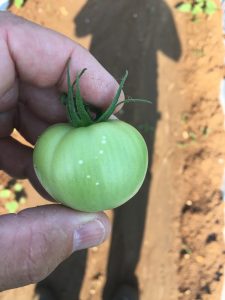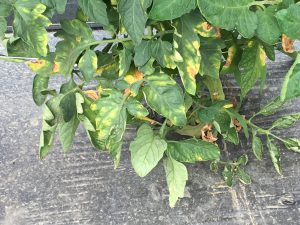Sweet Corn
European corn borer (ECB) moth catches continue to be extremely low around the state. We are in between adult generations at this time. ECB population maps will resume if second flight catches rise to high enough numbers.
The highest nightly trap catches of ECB for the week ending 07/20/22 are as follows:
| Allentown 1 | Old Bridge 1 |
| Dayton 1 | Sergeantsville 1 |
| Hillsborough 1 | South Branch 1 |
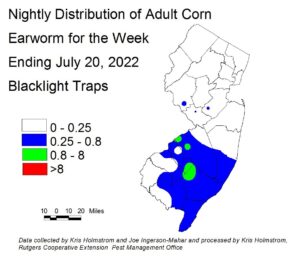 Corn earworm (CEW) moth captures from blacklight traps remain low, but pheromone trap captures have increased in some traps in parts of south Jersey. These few elevated pheromone catches have primarily occurred in the central Burlington and Gloucester/Salem County border regions and likely do not represent a regional increase. North Carolina trap catches are not showing consistent trends at this time, and Delaware catches are in range with New Jersey. Generally we see our larger influx of CEW adults after the first week of August. With elevated temperatures forecast for the near future, it is possible that we might get a somewhat earlier “hot season” for CEW. Check this publication weekly for CEW status. The number of pheromone traps deployed is much lower, resulting in much broader color bands on the map. It is also important to understand that pheromone traps are more sensitive than blacklight traps, and thresholds are adjusted to account for the higher catches typical of this trap type. Silking corn is at risk of CEW infestation at this time. On the blacklight map (left), green areas represent a 3-4 day silk spray schedule and blue represents a 4-5 day schedule. On the pheromone map (below right), red represents a 3 day spray schedule, green represents a 4-5 day schedule, and blue represents a 5-6 day schedule. Be sure to access information from this publication in the upcoming weeks to determine how frequently you should treat silking sweet corn to protect it from CEW infestation.
Corn earworm (CEW) moth captures from blacklight traps remain low, but pheromone trap captures have increased in some traps in parts of south Jersey. These few elevated pheromone catches have primarily occurred in the central Burlington and Gloucester/Salem County border regions and likely do not represent a regional increase. North Carolina trap catches are not showing consistent trends at this time, and Delaware catches are in range with New Jersey. Generally we see our larger influx of CEW adults after the first week of August. With elevated temperatures forecast for the near future, it is possible that we might get a somewhat earlier “hot season” for CEW. Check this publication weekly for CEW status. The number of pheromone traps deployed is much lower, resulting in much broader color bands on the map. It is also important to understand that pheromone traps are more sensitive than blacklight traps, and thresholds are adjusted to account for the higher catches typical of this trap type. Silking corn is at risk of CEW infestation at this time. On the blacklight map (left), green areas represent a 3-4 day silk spray schedule and blue represents a 4-5 day schedule. On the pheromone map (below right), red represents a 3 day spray schedule, green represents a 4-5 day schedule, and blue represents a 5-6 day schedule. Be sure to access information from this publication in the upcoming weeks to determine how frequently you should treat silking sweet corn to protect it from CEW infestation.
The highest nightly blacklight trap catches of CEW for the week ending 07/20/22 are as follows:
| Centerton 1 | Flanders 1 | Princeton 1 |
| Cinnaminson 1 | Folsom 1 | Sergeantsville 1 |
| Dayton 1 | Lawrenceville 1 | South Branch 1 |
| Elm 1 | Medford 1 | Tabernacle 1 |
The highest nightly pheromone trap catches of CEW for the week ending 07/20/22 are as follows:
| Beckett 65 | Cedarville 12 | Elm 4 |
| Tabernacle 38 | South Branch 5 | Matawan 4 |
| Pedricktown 19 | Allamuchy 4 | Folsom 3 |
| Monroeville 16 | East Vineland 4 | Dayton 2 |
Silking Spray Schedules*:
South – 3-4 days
Central – 4-5 days
North – 5-6 days
*These recommendations are based on regional catches. Adhere to tighter spray schedules if indicated by local trap catches. Synthetic pyrethroids alone should NOT be used for corn earworm (CEW) protection on silking corn, or for fall armyworm (FAW) management at any stage. Control with these materials is very inconsistent. Utilize materials in IRAC groups 5 and 28, or combination products that include IRAC group 28 for best control. See the Sweet Corn section of the 2020-21 Commercial Vegetable Production Guide for selections.
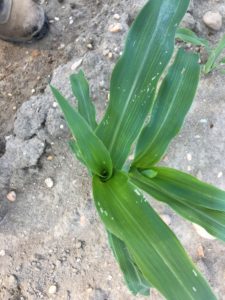
 Fall armyworm (FAW) larval infestations have declined around the state, with no recent injury reported in scouted fields. However, this is the time of the summer when FAW can show up, resulting in significant injury to whorl and even seedling stage corn. Injury from newly hatched larvae shows up as “window panes” or areas where leaf tissue has been eaten down the the lower epidermis (see photo at far left). This injury leads down into the whorl. As larvae gain size, they begin to consume leaf tissue in its’ entirety, creating ragged holes and lots of droppings (see photo at near left). FAW can be tough to manage because it is resistant to synthetic pyrethroid insecticides (IRAC 3A) and because larvae are often covered by their own droppings, making contact with the insecticide more difficult. Treat when 12% or more plants exhibit FAW injury alone, or in combination with ECB injury. As a rule, insecticides that are most effective on CEW will also adequately control FAW.
Fall armyworm (FAW) larval infestations have declined around the state, with no recent injury reported in scouted fields. However, this is the time of the summer when FAW can show up, resulting in significant injury to whorl and even seedling stage corn. Injury from newly hatched larvae shows up as “window panes” or areas where leaf tissue has been eaten down the the lower epidermis (see photo at far left). This injury leads down into the whorl. As larvae gain size, they begin to consume leaf tissue in its’ entirety, creating ragged holes and lots of droppings (see photo at near left). FAW can be tough to manage because it is resistant to synthetic pyrethroid insecticides (IRAC 3A) and because larvae are often covered by their own droppings, making contact with the insecticide more difficult. Treat when 12% or more plants exhibit FAW injury alone, or in combination with ECB injury. As a rule, insecticides that are most effective on CEW will also adequately control FAW.
With very hot temperatures, growers should be alert to the threat of sap beetle infestations in sweet corn. The ear tips of some corn varieties may grow through the husk under these conditions, allowing access to the kernels even without worm or bird injury. While the carbamate insecticide Lannate can provide control of this pest, growers may opt to include the neonicotinoid acetamiprid (Assail or Anarchy) with early silk sprays of less toxic materials. This material should limit sap beet increase in the plantings.
Tomatoes
As we move through July, brown stink bug injury is increasing. These true bugs (see photo of Euschistus sp. nymph below at left), move into irrigated tomato fields as forage in the surrounding environment dries out. Feeding results in “cloudy spot” (see photo at right below). Increases in stink bug injury are often found by crews picking the fruit. Growers should consider 1-2 insecticide applications to limit fruit injury if this damage is increasing in harvested fruit. If actively scouting fields, insecticides should be considered if stink bug adults, nymphs or new fruit injury is found in 2 or more sample sites in a 10 site sample. Insecticides that are effective on stink bugs include pyrethroids and neonicotinoids, so care should be taken to avoid contact with foraging bees.
Bacterial canker symptoms are fairly common in tomato plantings, but dry conditions have thus far limited the impact of this pathogen. Bacterial canker lesions (photos at lower right) on foliage often first appear as chlorotic triangles at the margins of lower leaves. These areas become necrotic and eventually entire leaves die. Canker lesions on fruit are white blisters on the surface of green fruit, and are quite characteristic. Care should be taken when working in plantings exhibiting symptoms of bacterial infections. Always work in younger plantings before older ones to avoid introducing pathogens to younger plants. Pruning, tying or harvesting when foliage is wet will spread bacterial diseases. When tying, it may be useful to place containers of 5% bleach solution at the ends of rows in which to dip the tying wands. This may help limit spread between rows.
Peppers
Two pepper weevils were found in a field in the Vineland area last week. So, far no additional weevils at that location have been found. Despite some advances in weevil control, they remain very difficult to manage. Fields should be treated as soon as possible after finding one weevil. The best control rotations include Vydate, a neonicotinoid (Actara, Admire, Assail, others), a diamide (Exirel, Harvanta), and possibly Torac. University of Georgia researchers have found that all populations of pepper weevil that they have tested are resistant to pyrethroids. Since we don’t know where the weevils come from that we find here in New Jersey, farmers probably shouldn’t rely on pyrethroids being effective. Refer to the Rutgers Fact Sheet, FS1330: Monitoring and Management of Pepper Weevil in New Jersey (Rutgers NJAES) for more details on monitoring pepper weevil populations.
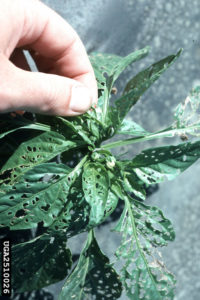 Fairly high numbers (38/night) of beet armyworm adults (BAW) were captured in a pheromone trap near Woodstown over the past week. As yet, no reports of feeding by this pest have surfaced, and no other captures have been noted. However, growers in Gloucester, Salem and Cumberland counties should monitor pepper fields weekly for signs of feeding. BAW larvae feed in the developing foliage in terminal growth of plants. Initially, leaves are skeletonized (photo at left, courtesy of Univ. of Ga.), but as larvae grow, they will move onto fruit and damage these as well. As with other armyworms, BAW is difficult to control with pyrethroid insecticides. Effective materials include spinosyns (IRAC 5) and diamides (IRAC 28).
Fairly high numbers (38/night) of beet armyworm adults (BAW) were captured in a pheromone trap near Woodstown over the past week. As yet, no reports of feeding by this pest have surfaced, and no other captures have been noted. However, growers in Gloucester, Salem and Cumberland counties should monitor pepper fields weekly for signs of feeding. BAW larvae feed in the developing foliage in terminal growth of plants. Initially, leaves are skeletonized (photo at left, courtesy of Univ. of Ga.), but as larvae grow, they will move onto fruit and damage these as well. As with other armyworms, BAW is difficult to control with pyrethroid insecticides. Effective materials include spinosyns (IRAC 5) and diamides (IRAC 28).
Pumpkins and Winter Squash
Cucurbit downy mildew (CDM) is active on cucumbers in all parts of the state. As yet, other cucurbits, including pumpkins, butternut squash, acorn squash and watermelons are affected. The storms of early this week resulted in elevated risk of infection throughout NJ, but as of Tuesday (7/19), the threat of new infections had diminished. For regional information on this important disease, see the Cucurbit Downy Mildew Forecast webpage: http://cdm.ipmpipe.org/. It is advisable that all growers treat preventively for CDM on cucumbers and muskmelons.
Cole Crops
 Recent hot weather (with prolonged periods of high nighttime temperatures) have resulted in leaf tip burn in many cole crops, both leafy types (kale, collards) and heading types like cabbage and cauliflower (see photo at left – courtesy of Rhea Bolar). This condition is similar to blossom end rot in tomatoes and peppers in that it is the result of inadequate supply of water (and thus calcium) to rapidly growing tissues. This is not a disease. While recent weather may make some of this unavoidable, it may be possible to mitigate it somewhat by maintaining steady soil moisture during hot, breezy spells of weather.
Recent hot weather (with prolonged periods of high nighttime temperatures) have resulted in leaf tip burn in many cole crops, both leafy types (kale, collards) and heading types like cabbage and cauliflower (see photo at left – courtesy of Rhea Bolar). This condition is similar to blossom end rot in tomatoes and peppers in that it is the result of inadequate supply of water (and thus calcium) to rapidly growing tissues. This is not a disease. While recent weather may make some of this unavoidable, it may be possible to mitigate it somewhat by maintaining steady soil moisture during hot, breezy spells of weather.
Kristian Holmstrom and Joseph Ingerson-Mahar would like to gratefully acknowledge the efforts of field technicians:
Claire Chapeau
Travis Kaye
Gabe Torres
Without the hard work of our field technicians, much of the information presented weekly in the IPM Update would be unobtainable.
